
In many organizations today, human resource management (HRM) professionals are overwhelmed by the sheer breadth of responsibilities. From recruitment, onboarding and payroll to compliance, alumni engagement and performance evaluation — the list goes on. One article notes that “anyone who’s worked in human resources knows that there are a host of HR issues that need to be managed, juggled and solved on a regular basis.” recruitee.com
On Reddit, HR pros also voice frustrations:
“The problem that I face is … my boss expects me to be peppy and with a big smile to everyone … along with providing customer service for applicants and current employees.” Reddit
When so much time is devoted to firefighting operations, there’s little bandwidth for strategic HRM initiatives, process redesign or continuous improvement.
Solution angle: By adopting a mindset of incremental improvement and building a cadence of short-cycles (for example weekly retrospectives or quick review of end-to-end workflows), HR teams can gradually simplify, standardize and eliminate waste — without needing a big-bang transformation. This approach aligns with modern HR skills and helps develop an agile HR model. The Agility in HR training helps address all of these pain points in practical and future-proof way.
Why is it so hard for HR to break down silos and rigid structures?
Rigid hierarchies and functional silos continue to hamper many HR functions. For example, in a study of European companies, 60% of organizations were still structured in a way described as “rigid” and siloed, making collaboration and adaptability difficult. Google Workspace
On Reddit, one HR practitioner put it bluntly:
Because HR often does not have direct decision-making authority, it becomes challenging to implement change across functions and improve organizational performance.
Solution angle: Introducing short feedback loops, cross-functional working gatherings and transparent backlog-style lists of HR improvement opportunities can help embed responsiveness and continuous adaptation — turning silos into fluid networks of work rather than fixed compartments. This approach enhances employee relations and supports a more dynamic workplace culture.
How can HR improve high-volume recruitment and the candidate experience?
Many HR teams struggle with the volume of applicants, the lack of personalization in communication and reputational risks from poor candidate experience. Industry commentary identifies this as a top HR challenge. Pollack Peacebuilding Systems+1
A Reddit thread echoes this:
“We started the hiring process a couple of weeks ago … there is so much backlash from employees … but our executive leadership remains completely silent.” Reddit
When candidate experience suffers, so does employer brand and overall talent management efforts.
Solution angle: Using a workflow-first approach — mapping each step of the candidate journey, defining ownership, and iterating quickly on communication templates and screening touchpoints — allows HR to reduce waste (for example redundant emails, unclear status updates) and improve transparency. The outcome: better candidate perception and smoother throughput. This strategy requires strong communication skills and active listening from HR professionals.
Why is HR technology under-leveraged and complex to adopt?
Many HR departments have invested in HRIS, applicant tracking systems or analytics platforms — but often they are not fully utilized. In a recent trends report:
“38% of HR practitioners are building AI skills by experimenting with tools … Self-exploration is the most common approach at the moment.” AIHR
Across the web:
“44% of organisations don’t fully utilise their HR software’s analytical capabilities.” recruitee.com
This gap between promise and practice arises because tools are deployed in an inflexible way, without incremental validation, continuous learning or defined ownership. HR automation and people analytics often remain underutilized.
Solution angle: Emphasizing small-scale pilots, short-cycle reviews of tool adoption and feedback from end-users (HR, hiring managers, employees) will enable HR teams to learn what works, incrementally scale adoption and avoid monolithic roll-outs. Over time this builds a culture where HR technology becomes an enabler rather than a burden. This approach also helps in developing crucial HR metrics and improving HR reporting capabilities.
How does HR build employee experience beyond onboarding?
Onboarding often gets the spotlight — but many HR functions stop tracking the employee journey soon after day 90 or the first month. Yet employee engagement, retention and continuous development are critical: as one source notes, disengagement leads to turnover and drains resources. Pollack Peacebuilding Systems
Further, external commentary shows employees frequently complain about “too much work,” “personality clash,” or a “hostile environment” — topics that show up in search behavior around HR questions. Human Resources Online
Solution angle: HR can map employee journeys as workflows, insert check-in gates (for example after 3 months, 6 months, 12 months), apply feedback loops (pulse surveys, focus groups), and iterate on improvements. By doing so regularly, HR shifts from a “one-time onboarding” mindset to continuous experience design. This approach enhances employee satisfaction, supports career planning, and contributes to overall employee wellbeing.
Why is HR’s influence often limited even when expectations are high?
Many HR professionals feel caught between operational expectations, strategic ambitions, and limited formal power. One Reddit user summarized it:
“Being in HR really sucks if management doesn’t value your role … and/or makes you the fall guy for every decision that negatively impacts employees.” Reddit
At the same time, major publications state that HR executives face key challenges including bad managers, low morale, and economic pressures. Forbes
Solution angle: Instead of waiting for authority, HR can adopt a mindset of experiment-and-learn — running small, visible improvement initiatives, measuring outcomes (turnaround time, candidate satisfaction, manager feedback), sharing results widely, and gradually earning influence. The iterative, transparent approach builds credibility and converts HR from “service function” to “value-delivery partner”. This strategy requires business acumen, stakeholder management skills, and a focus on the HR value chain.
Closing: Why these pain points point to the value of HR agility
The recurring themes above — overloaded operations, rigid structures, under-used tools, inconsistent experience design, limited influence — are symptoms of an HR model that relies on static structures and linear plans in a world of dynamic change.
There is a different path: one where HR teams adopt a way of working that emphasizes small-cycle improvement, cross-functional collaboration, continuous feedback, and people-centered process design. This way of working transforms HR from reactive to proactive, from tactical to strategic.
If you’re seeing these pain points in your organization, it’s not just about hiring more people or buying more tools. It’s about changing the rhythm and structure of how work happens in HR. That’s where true transformation lies — and where a more adaptive, learning-oriented HR function can emerge. By embracing an agile HR model, focusing on strategic HRM, and continuously developing HR skills, human resource management can truly become a driver of organizational performance and workplace culture.

Bhavna is an Agile Coach and Consultant with 15+ years of experience in advisory, corporate finance, IT assurance, and operations at Big 4 and within the industry in the UK and India. She has recently been the CEO of a start-up where she implemented agile practices within HR, Marketing, and Product teams.
She is also a SAFe® Practice Consultant (SPC) and authorized instructor for ICAgile Agility in HR (ICP-AHR), Agility in Marketing (ICP-MKG), and Business Agility Foundations (ICP – BAF) training courses. She provides training for agile transformation to corporate, public, and private batches, as well as consulting for enterprise agile transformation.






